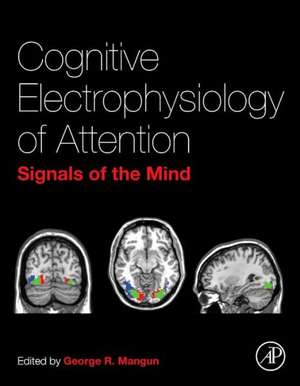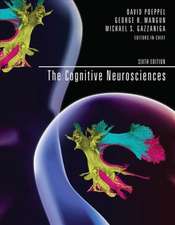Cognitive Electrophysiology of Attention: Signals of the Mind
Editat de George R. Mangunen Limba Engleză Hardback – 23 oct 2013
- Provides an exhaustive overview of attention processes, going from normal functioning to the pathological, and using a combination of methodological tools
- An important reference for electrophysiology researchers looking at underlying attention processes rather than the methods themselves
- Enables researchers across a broad range of cognitive-process and methodological specialties to stay current on particular hypotheses, findings, and methods
- Edited and authored by the worldwide leaders in the field, affording the broadest, most expert coverage available
Preț: 438.73 lei
Preț vechi: 576.01 lei
-24% Nou
Puncte Express: 658
Preț estimativ în valută:
83.95€ • 89.77$ • 69.100£
83.95€ • 89.77$ • 69.100£
Carte tipărită la comandă
Livrare economică 11-25 aprilie
Preluare comenzi: 021 569.72.76
Specificații
ISBN-13: 9780123984517
ISBN-10: 0123984513
Pagini: 304
Ilustrații: black & white tables, figures
Dimensiuni: 216 x 276 x 20 mm
Greutate: 1.13 kg
Editura: ELSEVIER SCIENCE
ISBN-10: 0123984513
Pagini: 304
Ilustrații: black & white tables, figures
Dimensiuni: 216 x 276 x 20 mm
Greutate: 1.13 kg
Editura: ELSEVIER SCIENCE
Public țintă
Neuroscientists, cognitive neuroscientists and cognitive psychologists; academic neurologists and psychiatrists with research careersCuprins
Section 1: Spatial Attention
1. Profiling the Spatial Focus of Visual Attention
2. How the Brain Prevents and Terminates Shifts of Attention
3. Neuronal and Neural-Population Mechanisms of Voluntary Visual-Spatial Attention
4. Sequential Effects in the Central Cue Posner Paradigm – On-line Bayesian Learning
5. ERP-fMRI Combination for the Study of Visual Perception and Spatial Attention
6. Source Localization of Visual Stimuli in Peripersonal Space
7. Involuntary Cross-Modal Spatial Attention Influences Visual Perception
Section 2: Feature and Object Attention
8. Object-Category Processing, Perceptual Awareness, and the Role of Attention during Motion-Induced Blindness
9. Feature- and Object-Based Attention: Electrophysiological and Hemodynamic Correlates
10. Neural Mechanisms of Feature-Based Attention
11. Effects of Preparatory Attention to Non-Spatial Features in the Visual Cortex
12. The Neural Basis of Color Binding to an Attended Object
13. Switching Attention between the Local and Global Levels in Visual Objects
14. Contour Integration: Sensory, Perceptual, and Attention-Based ERP Components
15. Attentional Control of Multisensory Integration is Preserved in Aging
Section 3: Attention and Cognitive Processes
16. An Evolutionary Perspective on Attentional Processes
17. Stimulus-Preceding Negativity (SPN) And Attention to Rewards
18. A Neural Measure of Item Individuation
19. Selective Attention, Processing Load, and Semantics: Insights from Human Electrophysiology
20. Altered N400 Congruity Effects in Parkinson’s Disease Without Dementia
21. Oscillations and Behavior: The Role of Phase-Amplitude Coupling in Cognition
1. Profiling the Spatial Focus of Visual Attention
2. How the Brain Prevents and Terminates Shifts of Attention
3. Neuronal and Neural-Population Mechanisms of Voluntary Visual-Spatial Attention
4. Sequential Effects in the Central Cue Posner Paradigm – On-line Bayesian Learning
5. ERP-fMRI Combination for the Study of Visual Perception and Spatial Attention
6. Source Localization of Visual Stimuli in Peripersonal Space
7. Involuntary Cross-Modal Spatial Attention Influences Visual Perception
Section 2: Feature and Object Attention
8. Object-Category Processing, Perceptual Awareness, and the Role of Attention during Motion-Induced Blindness
9. Feature- and Object-Based Attention: Electrophysiological and Hemodynamic Correlates
10. Neural Mechanisms of Feature-Based Attention
11. Effects of Preparatory Attention to Non-Spatial Features in the Visual Cortex
12. The Neural Basis of Color Binding to an Attended Object
13. Switching Attention between the Local and Global Levels in Visual Objects
14. Contour Integration: Sensory, Perceptual, and Attention-Based ERP Components
15. Attentional Control of Multisensory Integration is Preserved in Aging
Section 3: Attention and Cognitive Processes
16. An Evolutionary Perspective on Attentional Processes
17. Stimulus-Preceding Negativity (SPN) And Attention to Rewards
18. A Neural Measure of Item Individuation
19. Selective Attention, Processing Load, and Semantics: Insights from Human Electrophysiology
20. Altered N400 Congruity Effects in Parkinson’s Disease Without Dementia
21. Oscillations and Behavior: The Role of Phase-Amplitude Coupling in Cognition
Recenzii
"Although this would generally not be a read-from-page-to-page composite, this book is elemental in that it builds on itself from chapter to chapter. It would not be advised to take on research of this strength without some background information on the topics of bias, neurophysiology, and mental health." --Doody
"Editor Mangun presents this text on the neural mechanisms of attention in three parts, drawing on EEG, ERP, fMRI, and neural population research. Part I discusses spatial attention,…Part II addresses higher-order processes of feature and object attention,...Part III explores the interaction of attention with cognitive processes,…" --ProtoView.com, February 2014
"Editor Mangun presents this text on the neural mechanisms of attention in three parts, drawing on EEG, ERP, fMRI, and neural population research. Part I discusses spatial attention,…Part II addresses higher-order processes of feature and object attention,...Part III explores the interaction of attention with cognitive processes,…" --ProtoView.com, February 2014



















